MAKER: CHARLES BAKER COMPANY
MODEL: 'Nelson No. 2' -a comparison of two different examples
c. 1895 & C. 1899
SIGNED:'C. BAKER, 244, HIGH HOLBORN, LONDON'
SERIAL NUMBER: none
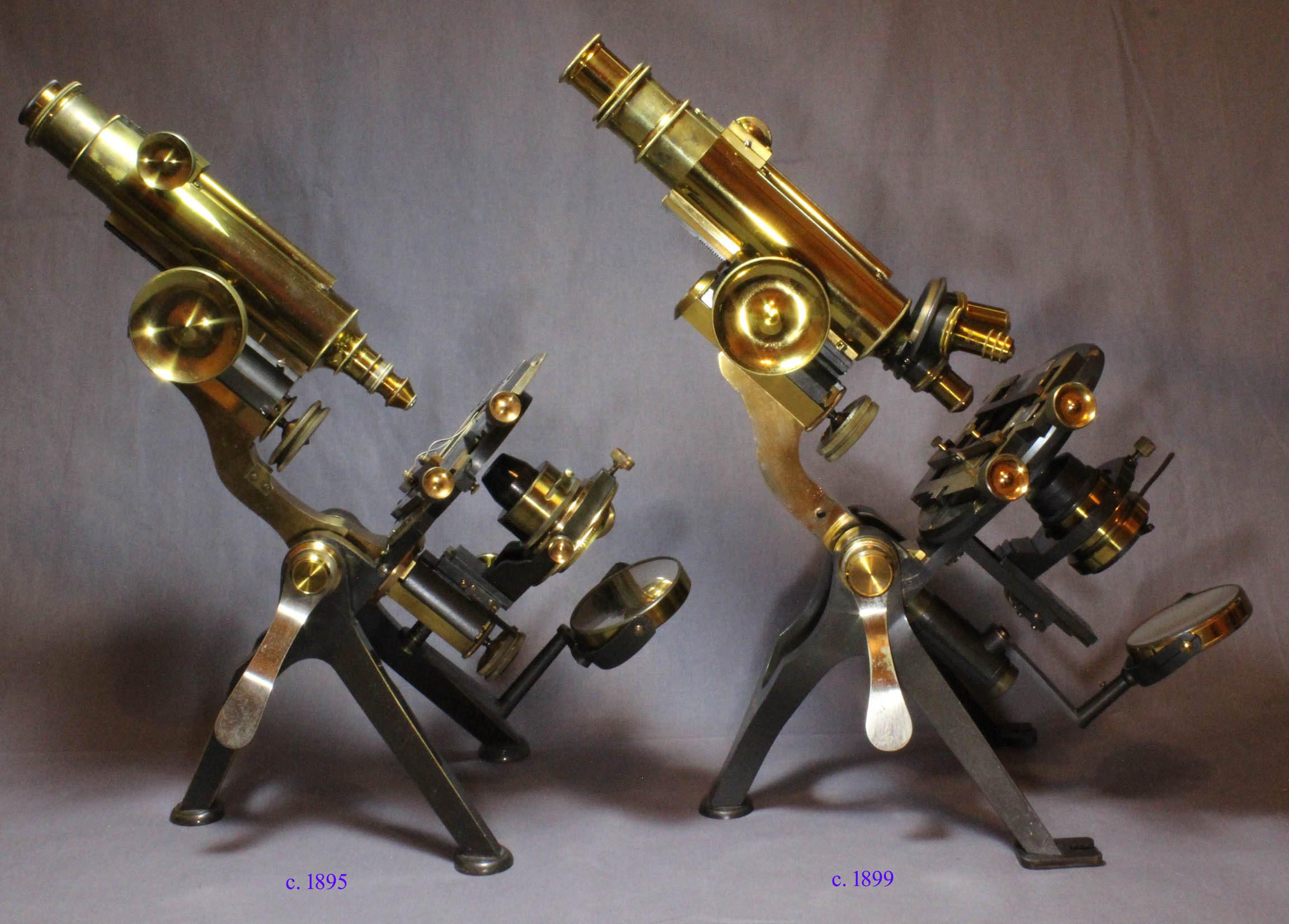
Because I have been fortunate enough to own two different examples of the Nelson-Curties No 2 microscope, I have been able to compare each example closely. This page discusses the similarities and differences. It illustrates first hand how it is common to see subtle changes in the design of antique microscopes over the years even if not specifically mentioned in the literature; they were not static and indeed often changed without notice and without a change in the engravings of them.
First we need to be clear about what we are talking about on this web page. As time went on, certain features which were standard became optional, or not even offered. I have discussed these on another page devoted to the history of Nelson Microscopes. On the page you are currently on, I will concentrate on things that appeared similar, but actually changed, usually not mentioned in the catalogs.
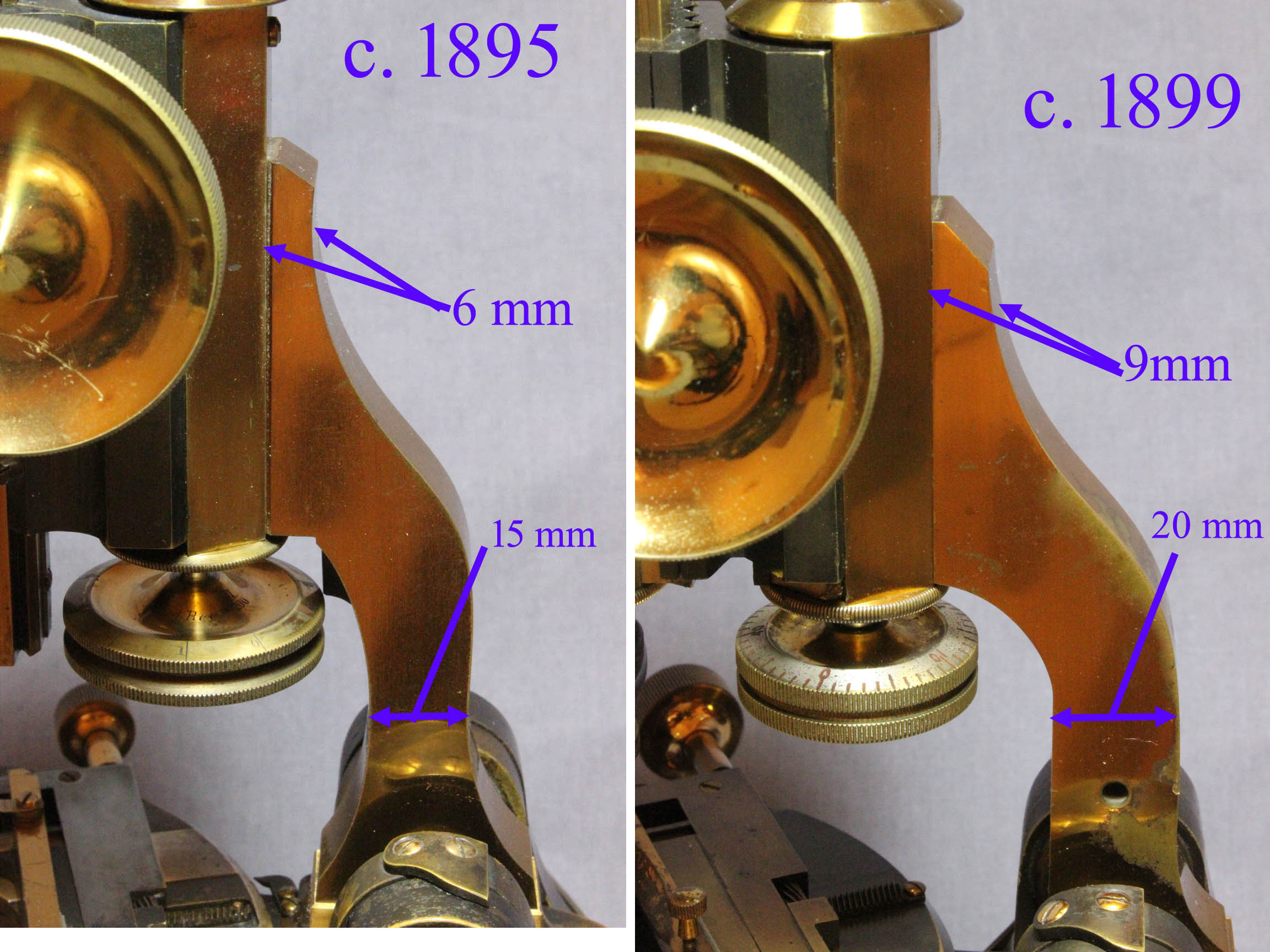 First lets look at the limb. At first glance all the number twos would appear to have exactly the same limb. This is not quite true. Although the style remained the same, as time went on it is clear that the limb no longer tapered slightly in its center, and became thicker, and more uniform, in the forward-backward dimension. My No 2 from 1895 narrows and has a thickness of 15 mm at its midpoint, but on the 1899 model, it is completely straight, and is a substantially thicker 20 mm. What's more, the portion that attaches to the optical tube is also thicker on the later model, measuring only 6 mm on the 1895 version and 9 mm on the 1899 version. The earlier model did not have a hole in the limb for accessories but the 1899 example does.
First lets look at the limb. At first glance all the number twos would appear to have exactly the same limb. This is not quite true. Although the style remained the same, as time went on it is clear that the limb no longer tapered slightly in its center, and became thicker, and more uniform, in the forward-backward dimension. My No 2 from 1895 narrows and has a thickness of 15 mm at its midpoint, but on the 1899 model, it is completely straight, and is a substantially thicker 20 mm. What's more, the portion that attaches to the optical tube is also thicker on the later model, measuring only 6 mm on the 1895 version and 9 mm on the 1899 version. The earlier model did not have a hole in the limb for accessories but the 1899 example does.
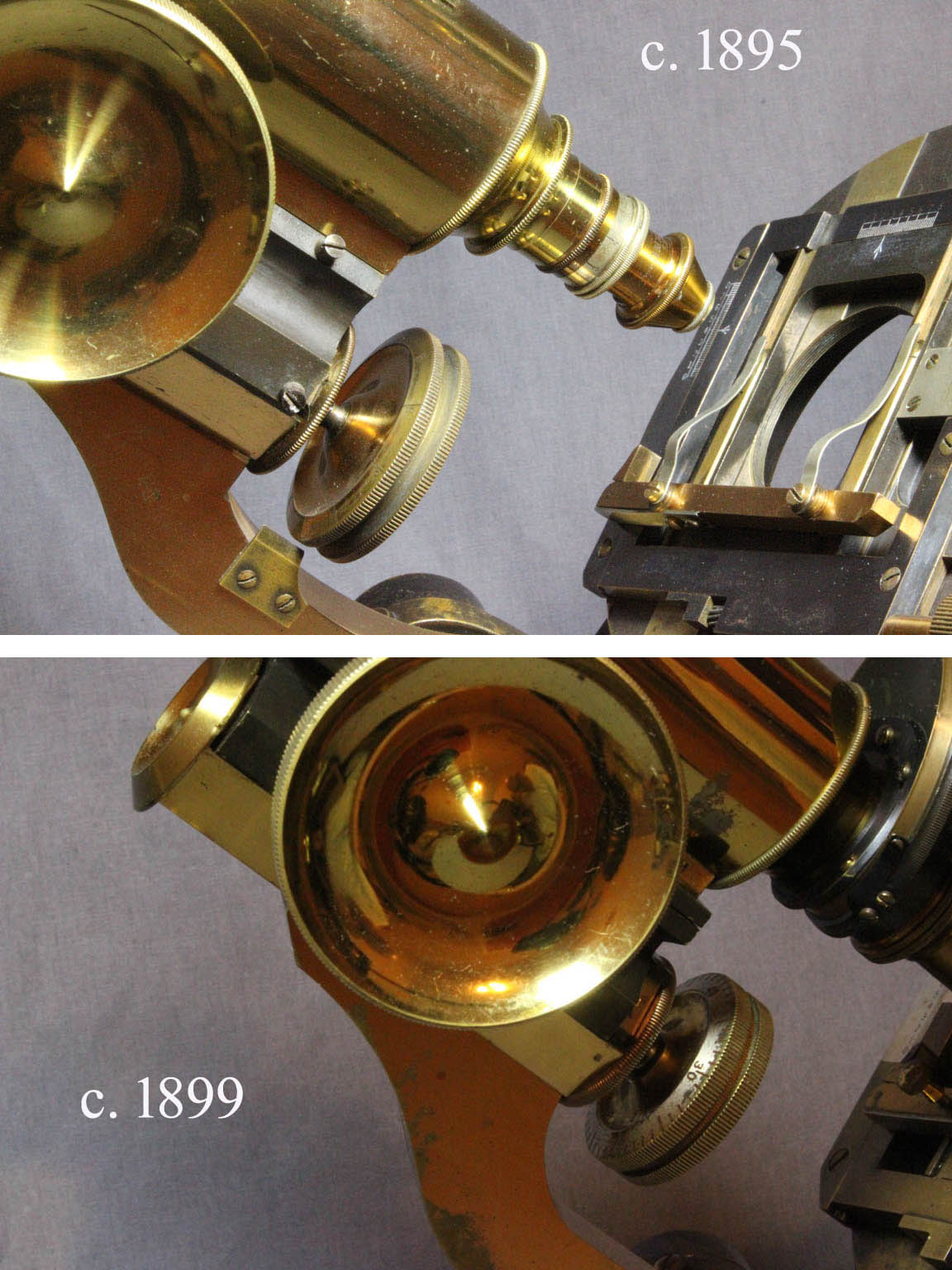 The fine focus knob also changed. It is much thicker on the 1899 model. The 1899 knob had additional calibrations between the numbers, whereas the 1895 model did not. In addition there is a fine focus cursor on the 1895 version, but none on the 1899 example. One would suppose the edge of the limb could be used as a cursor.
The fine focus knob also changed. It is much thicker on the 1899 model. The 1899 knob had additional calibrations between the numbers, whereas the 1895 model did not. In addition there is a fine focus cursor on the 1895 version, but none on the 1899 example. One would suppose the edge of the limb could be used as a cursor.
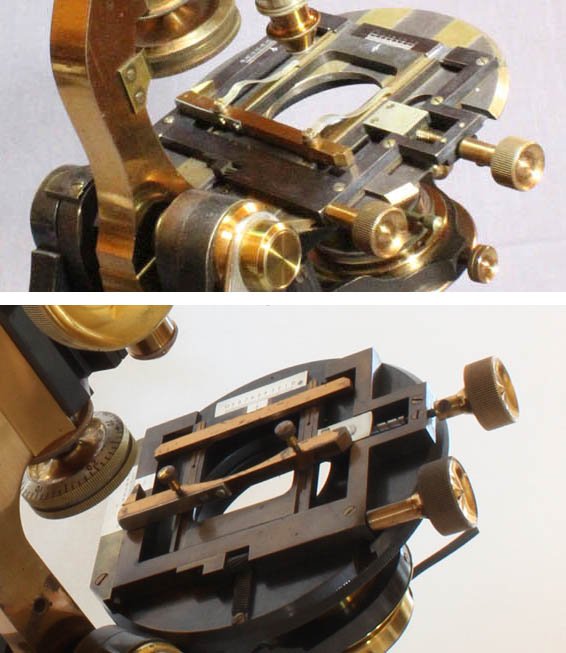 The same type of mechanical stage was provided on both examples, yet there are some differences. The knobs for motion of the mechanical stage were of a much larger diameter on the later model of 1899 (bottom left). The slide location scales on the earlier model are engraved directly on the brass and colored white. In the 1899 model(bottom left) small engraved nickel plates were used instead. The threads on the worm screw controlling right-left motion are much finer on the earlier 1895 version than on the 1899 version. As is shown in the 1895 catalog, stage clips were provided on the earlier model rather than two bars to hold the slide as in the later model.
The same type of mechanical stage was provided on both examples, yet there are some differences. The knobs for motion of the mechanical stage were of a much larger diameter on the later model of 1899 (bottom left). The slide location scales on the earlier model are engraved directly on the brass and colored white. In the 1899 model(bottom left) small engraved nickel plates were used instead. The threads on the worm screw controlling right-left motion are much finer on the earlier 1895 version than on the 1899 version. As is shown in the 1895 catalog, stage clips were provided on the earlier model rather than two bars to hold the slide as in the later model.
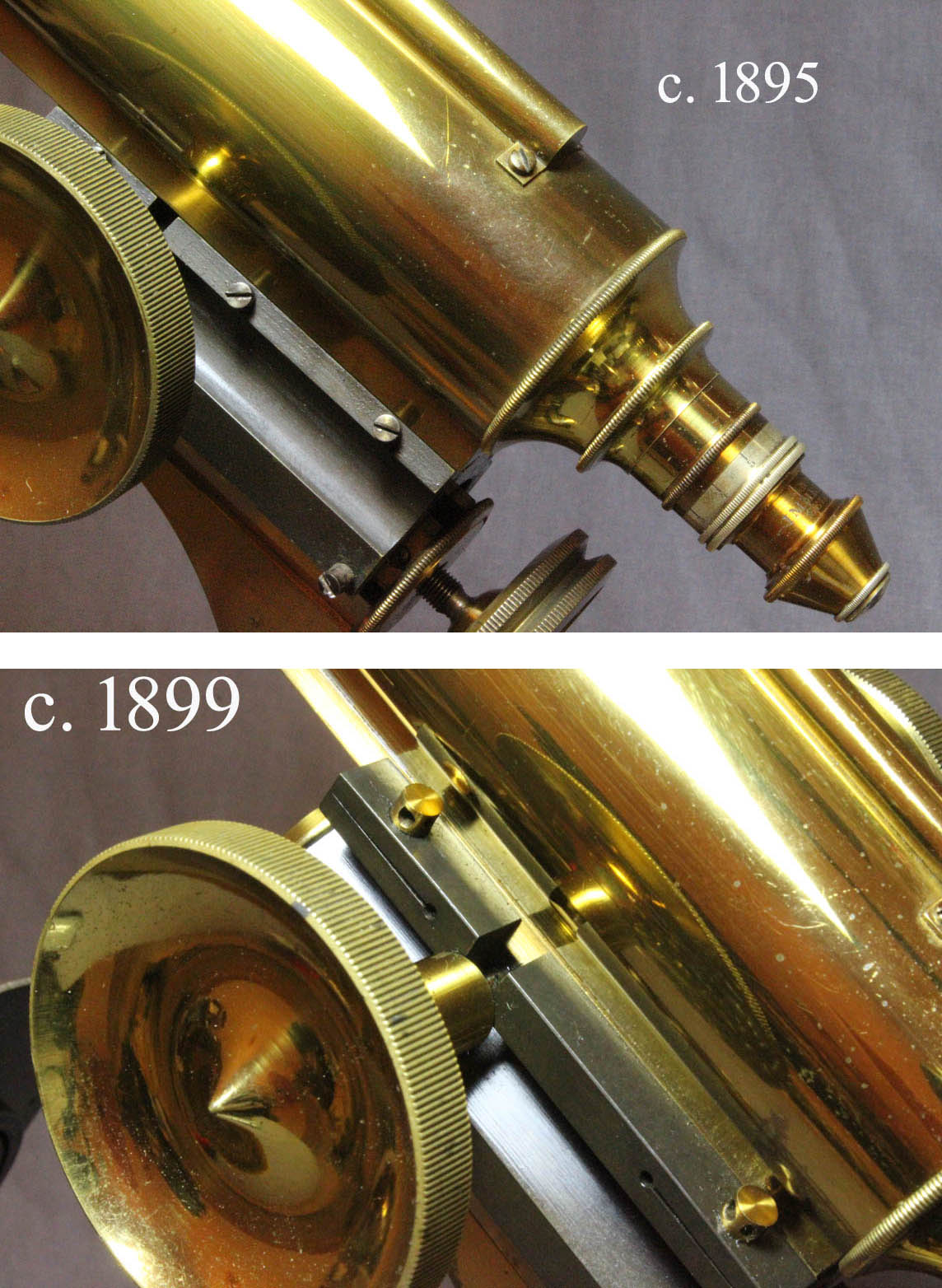 Finally, the design of the mechanics to take up wear are different on the two microscopes. The direction of adjustment as well as the type of screw changed as time went on. The earlier model used blackened slotted steel screws. The later version used lacquered brass screws with holes on the sides of the heads. A strong metal rod of the correct diameter is required to adjust these.
Finally, the design of the mechanics to take up wear are different on the two microscopes. The direction of adjustment as well as the type of screw changed as time went on. The earlier model used blackened slotted steel screws. The later version used lacquered brass screws with holes on the sides of the heads. A strong metal rod of the correct diameter is required to adjust these.

 First lets look at the limb. At first glance all the number twos would appear to have exactly the same limb. This is not quite true. Although the style remained the same, as time went on it is clear that the limb no longer tapered slightly in its center, and became thicker, and more uniform, in the forward-backward dimension. My No 2 from 1895 narrows and has a thickness of 15 mm at its midpoint, but on the 1899 model, it is completely straight, and is a substantially thicker 20 mm. What's more, the portion that attaches to the optical tube is also thicker on the later model, measuring only 6 mm on the 1895 version and 9 mm on the 1899 version. The earlier model did not have a hole in the limb for accessories but the 1899 example does.
First lets look at the limb. At first glance all the number twos would appear to have exactly the same limb. This is not quite true. Although the style remained the same, as time went on it is clear that the limb no longer tapered slightly in its center, and became thicker, and more uniform, in the forward-backward dimension. My No 2 from 1895 narrows and has a thickness of 15 mm at its midpoint, but on the 1899 model, it is completely straight, and is a substantially thicker 20 mm. What's more, the portion that attaches to the optical tube is also thicker on the later model, measuring only 6 mm on the 1895 version and 9 mm on the 1899 version. The earlier model did not have a hole in the limb for accessories but the 1899 example does.
 The fine focus knob also changed. It is much thicker on the 1899 model. The 1899 knob had additional calibrations between the numbers, whereas the 1895 model did not. In addition there is a fine focus cursor on the 1895 version, but none on the 1899 example. One would suppose the edge of the limb could be used as a cursor.
The fine focus knob also changed. It is much thicker on the 1899 model. The 1899 knob had additional calibrations between the numbers, whereas the 1895 model did not. In addition there is a fine focus cursor on the 1895 version, but none on the 1899 example. One would suppose the edge of the limb could be used as a cursor.  The same type of mechanical stage was provided on both examples, yet there are some differences. The knobs for motion of the mechanical stage were of a much larger diameter on the later model of 1899 (bottom left). The slide location scales on the earlier model are engraved directly on the brass and colored white. In the 1899 model(bottom left) small engraved nickel plates were used instead. The threads on the worm screw controlling right-left motion are much finer on the earlier 1895 version than on the 1899 version. As is shown in the 1895 catalog, stage clips were provided on the earlier model rather than two bars to hold the slide as in the later model.
The same type of mechanical stage was provided on both examples, yet there are some differences. The knobs for motion of the mechanical stage were of a much larger diameter on the later model of 1899 (bottom left). The slide location scales on the earlier model are engraved directly on the brass and colored white. In the 1899 model(bottom left) small engraved nickel plates were used instead. The threads on the worm screw controlling right-left motion are much finer on the earlier 1895 version than on the 1899 version. As is shown in the 1895 catalog, stage clips were provided on the earlier model rather than two bars to hold the slide as in the later model.
 Finally, the design of the mechanics to take up wear are different on the two microscopes. The direction of adjustment as well as the type of screw changed as time went on. The earlier model used blackened slotted steel screws. The later version used lacquered brass screws with holes on the sides of the heads. A strong metal rod of the correct diameter is required to adjust these.
Finally, the design of the mechanics to take up wear are different on the two microscopes. The direction of adjustment as well as the type of screw changed as time went on. The earlier model used blackened slotted steel screws. The later version used lacquered brass screws with holes on the sides of the heads. A strong metal rod of the correct diameter is required to adjust these.